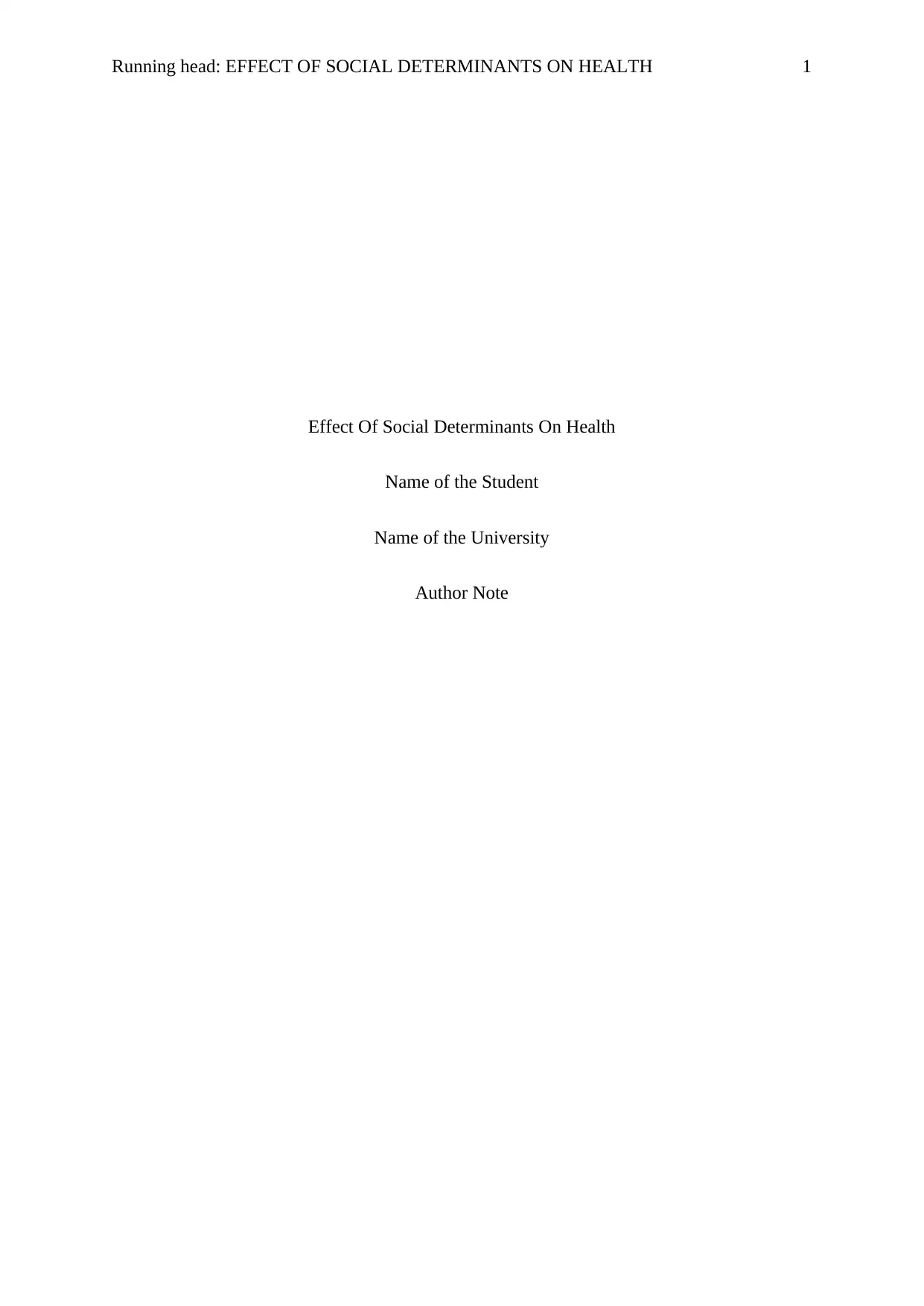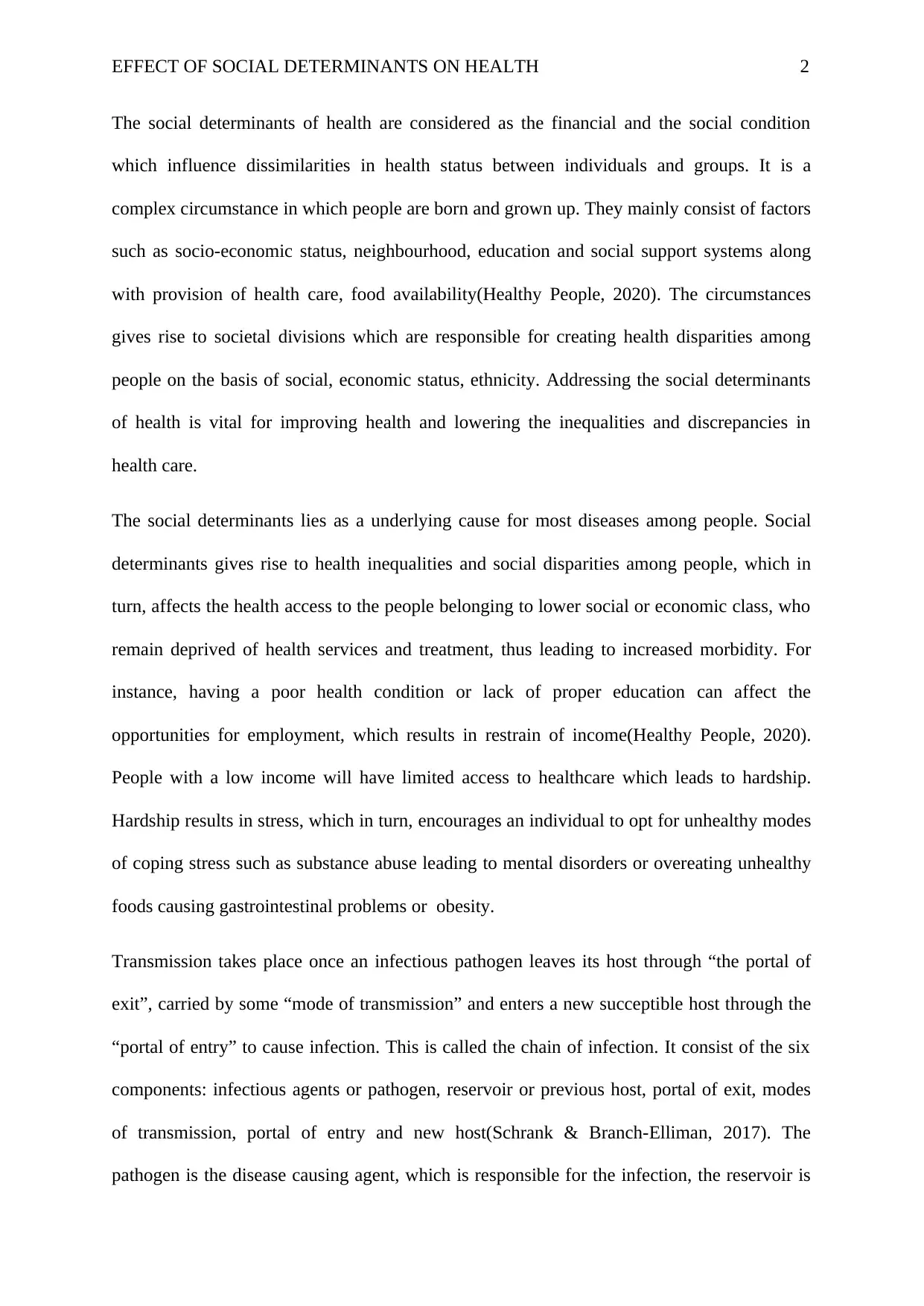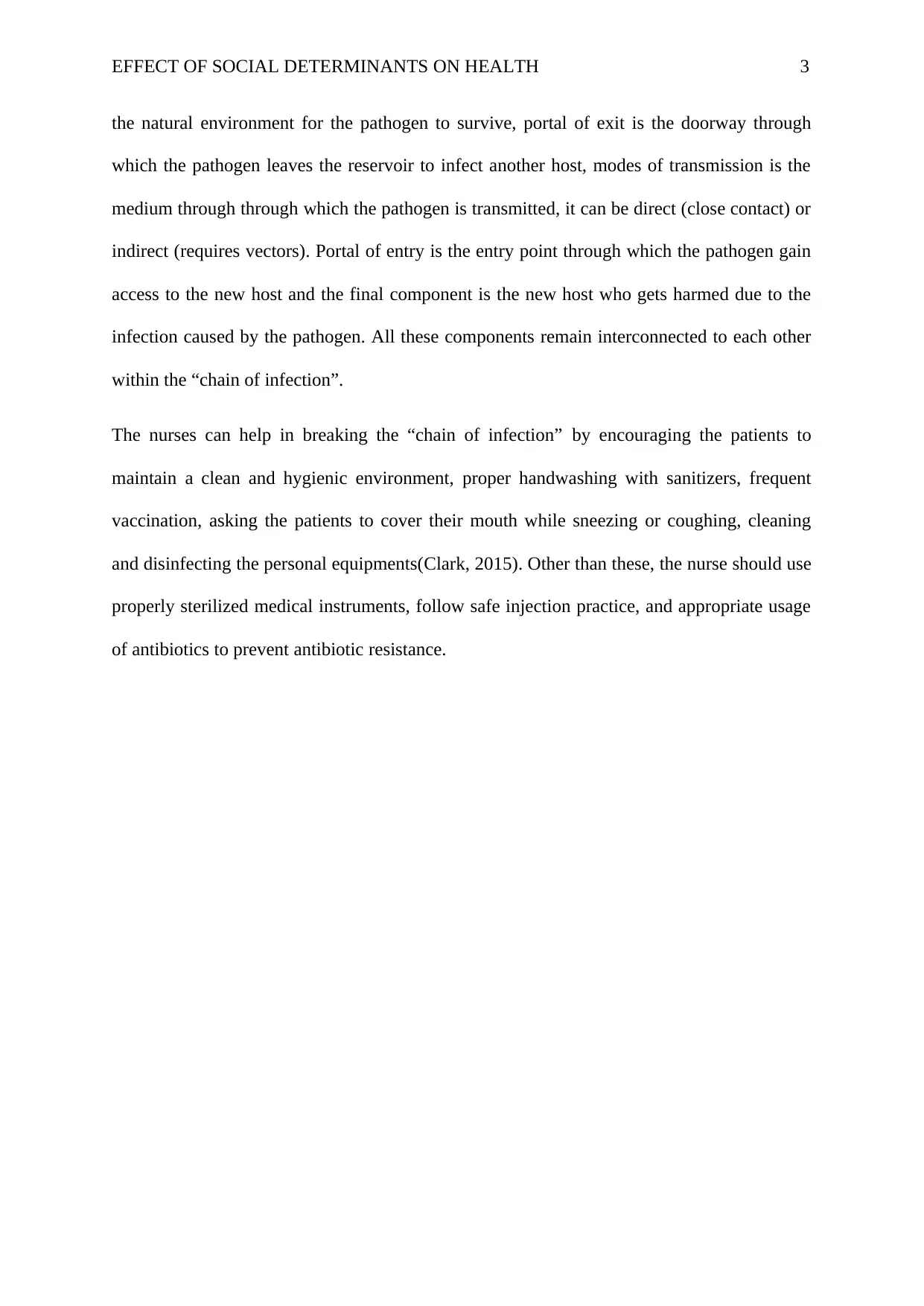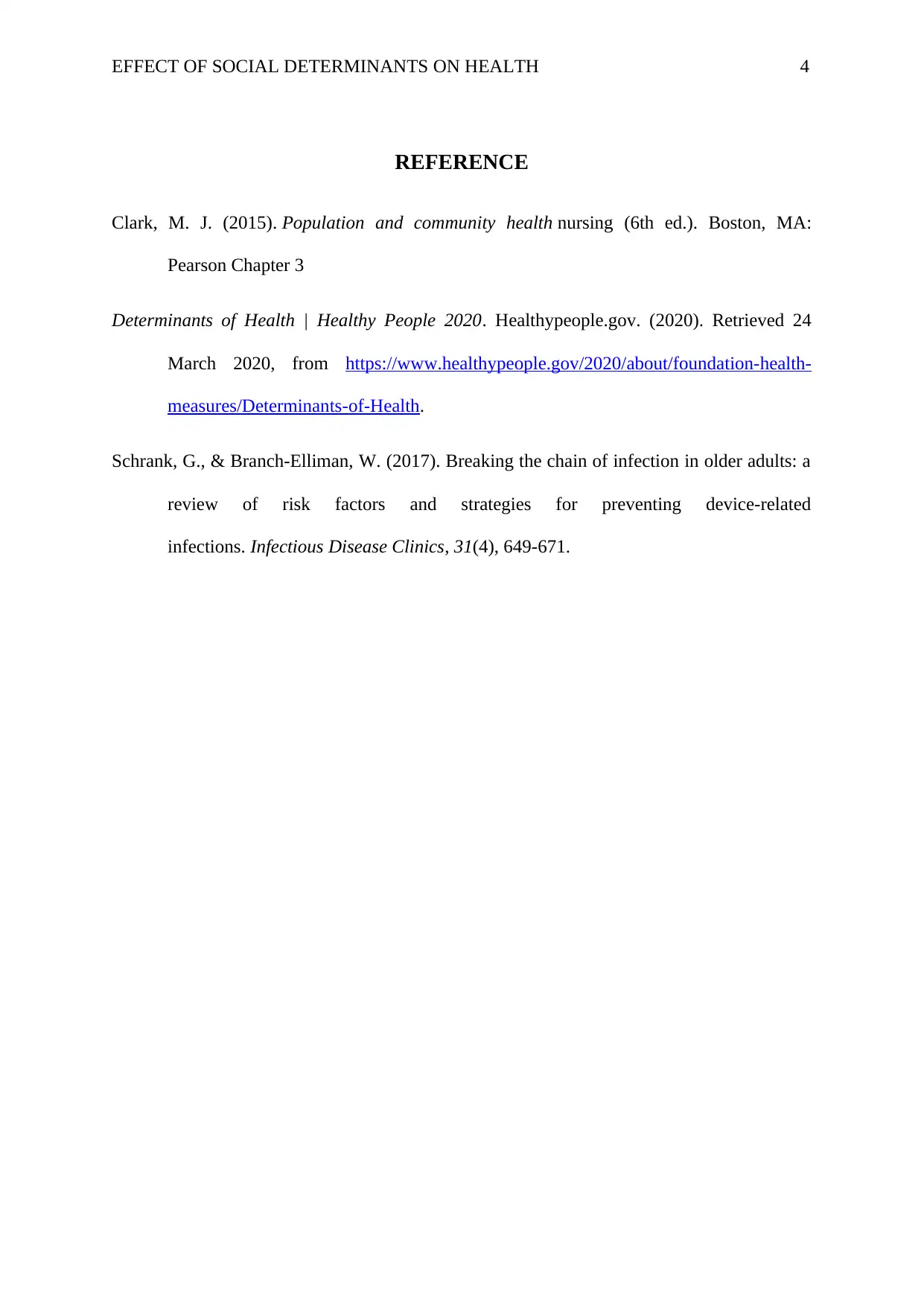The Influence of Social Determinants on Health
VerifiedAdded on 2022/08/26
|4
|697
|13
AI Summary
Contribute Materials
Your contribution can guide someone’s learning journey. Share your
documents today.

Running head: EFFECT OF SOCIAL DETERMINANTS ON HEALTH 1
Effect Of Social Determinants On Health
Name of the Student
Name of the University
Author Note
Effect Of Social Determinants On Health
Name of the Student
Name of the University
Author Note
Secure Best Marks with AI Grader
Need help grading? Try our AI Grader for instant feedback on your assignments.

EFFECT OF SOCIAL DETERMINANTS ON HEALTH 2
The social determinants of health are considered as the financial and the social condition
which influence dissimilarities in health status between individuals and groups. It is a
complex circumstance in which people are born and grown up. They mainly consist of factors
such as socio-economic status, neighbourhood, education and social support systems along
with provision of health care, food availability(Healthy People, 2020). The circumstances
gives rise to societal divisions which are responsible for creating health disparities among
people on the basis of social, economic status, ethnicity. Addressing the social determinants
of health is vital for improving health and lowering the inequalities and discrepancies in
health care.
The social determinants lies as a underlying cause for most diseases among people. Social
determinants gives rise to health inequalities and social disparities among people, which in
turn, affects the health access to the people belonging to lower social or economic class, who
remain deprived of health services and treatment, thus leading to increased morbidity. For
instance, having a poor health condition or lack of proper education can affect the
opportunities for employment, which results in restrain of income(Healthy People, 2020).
People with a low income will have limited access to healthcare which leads to hardship.
Hardship results in stress, which in turn, encourages an individual to opt for unhealthy modes
of coping stress such as substance abuse leading to mental disorders or overeating unhealthy
foods causing gastrointestinal problems or obesity.
Transmission takes place once an infectious pathogen leaves its host through “the portal of
exit”, carried by some “mode of transmission” and enters a new succeptible host through the
“portal of entry” to cause infection. This is called the chain of infection. It consist of the six
components: infectious agents or pathogen, reservoir or previous host, portal of exit, modes
of transmission, portal of entry and new host(Schrank & Branch-Elliman, 2017). The
pathogen is the disease causing agent, which is responsible for the infection, the reservoir is
The social determinants of health are considered as the financial and the social condition
which influence dissimilarities in health status between individuals and groups. It is a
complex circumstance in which people are born and grown up. They mainly consist of factors
such as socio-economic status, neighbourhood, education and social support systems along
with provision of health care, food availability(Healthy People, 2020). The circumstances
gives rise to societal divisions which are responsible for creating health disparities among
people on the basis of social, economic status, ethnicity. Addressing the social determinants
of health is vital for improving health and lowering the inequalities and discrepancies in
health care.
The social determinants lies as a underlying cause for most diseases among people. Social
determinants gives rise to health inequalities and social disparities among people, which in
turn, affects the health access to the people belonging to lower social or economic class, who
remain deprived of health services and treatment, thus leading to increased morbidity. For
instance, having a poor health condition or lack of proper education can affect the
opportunities for employment, which results in restrain of income(Healthy People, 2020).
People with a low income will have limited access to healthcare which leads to hardship.
Hardship results in stress, which in turn, encourages an individual to opt for unhealthy modes
of coping stress such as substance abuse leading to mental disorders or overeating unhealthy
foods causing gastrointestinal problems or obesity.
Transmission takes place once an infectious pathogen leaves its host through “the portal of
exit”, carried by some “mode of transmission” and enters a new succeptible host through the
“portal of entry” to cause infection. This is called the chain of infection. It consist of the six
components: infectious agents or pathogen, reservoir or previous host, portal of exit, modes
of transmission, portal of entry and new host(Schrank & Branch-Elliman, 2017). The
pathogen is the disease causing agent, which is responsible for the infection, the reservoir is

EFFECT OF SOCIAL DETERMINANTS ON HEALTH 3
the natural environment for the pathogen to survive, portal of exit is the doorway through
which the pathogen leaves the reservoir to infect another host, modes of transmission is the
medium through through which the pathogen is transmitted, it can be direct (close contact) or
indirect (requires vectors). Portal of entry is the entry point through which the pathogen gain
access to the new host and the final component is the new host who gets harmed due to the
infection caused by the pathogen. All these components remain interconnected to each other
within the “chain of infection”.
The nurses can help in breaking the “chain of infection” by encouraging the patients to
maintain a clean and hygienic environment, proper handwashing with sanitizers, frequent
vaccination, asking the patients to cover their mouth while sneezing or coughing, cleaning
and disinfecting the personal equipments(Clark, 2015). Other than these, the nurse should use
properly sterilized medical instruments, follow safe injection practice, and appropriate usage
of antibiotics to prevent antibiotic resistance.
the natural environment for the pathogen to survive, portal of exit is the doorway through
which the pathogen leaves the reservoir to infect another host, modes of transmission is the
medium through through which the pathogen is transmitted, it can be direct (close contact) or
indirect (requires vectors). Portal of entry is the entry point through which the pathogen gain
access to the new host and the final component is the new host who gets harmed due to the
infection caused by the pathogen. All these components remain interconnected to each other
within the “chain of infection”.
The nurses can help in breaking the “chain of infection” by encouraging the patients to
maintain a clean and hygienic environment, proper handwashing with sanitizers, frequent
vaccination, asking the patients to cover their mouth while sneezing or coughing, cleaning
and disinfecting the personal equipments(Clark, 2015). Other than these, the nurse should use
properly sterilized medical instruments, follow safe injection practice, and appropriate usage
of antibiotics to prevent antibiotic resistance.

EFFECT OF SOCIAL DETERMINANTS ON HEALTH 4
REFERENCE
Clark, M. J. (2015). Population and community health nursing (6th ed.). Boston, MA:
Pearson Chapter 3
Determinants of Health | Healthy People 2020. Healthypeople.gov. (2020). Retrieved 24
March 2020, from https://www.healthypeople.gov/2020/about/foundation-health-
measures/Determinants-of-Health.
Schrank, G., & Branch-Elliman, W. (2017). Breaking the chain of infection in older adults: a
review of risk factors and strategies for preventing device-related
infections. Infectious Disease Clinics, 31(4), 649-671.
REFERENCE
Clark, M. J. (2015). Population and community health nursing (6th ed.). Boston, MA:
Pearson Chapter 3
Determinants of Health | Healthy People 2020. Healthypeople.gov. (2020). Retrieved 24
March 2020, from https://www.healthypeople.gov/2020/about/foundation-health-
measures/Determinants-of-Health.
Schrank, G., & Branch-Elliman, W. (2017). Breaking the chain of infection in older adults: a
review of risk factors and strategies for preventing device-related
infections. Infectious Disease Clinics, 31(4), 649-671.
1 out of 4
Related Documents
Your All-in-One AI-Powered Toolkit for Academic Success.
+13062052269
info@desklib.com
Available 24*7 on WhatsApp / Email
![[object Object]](/_next/static/media/star-bottom.7253800d.svg)
Unlock your academic potential
© 2024 | Zucol Services PVT LTD | All rights reserved.





